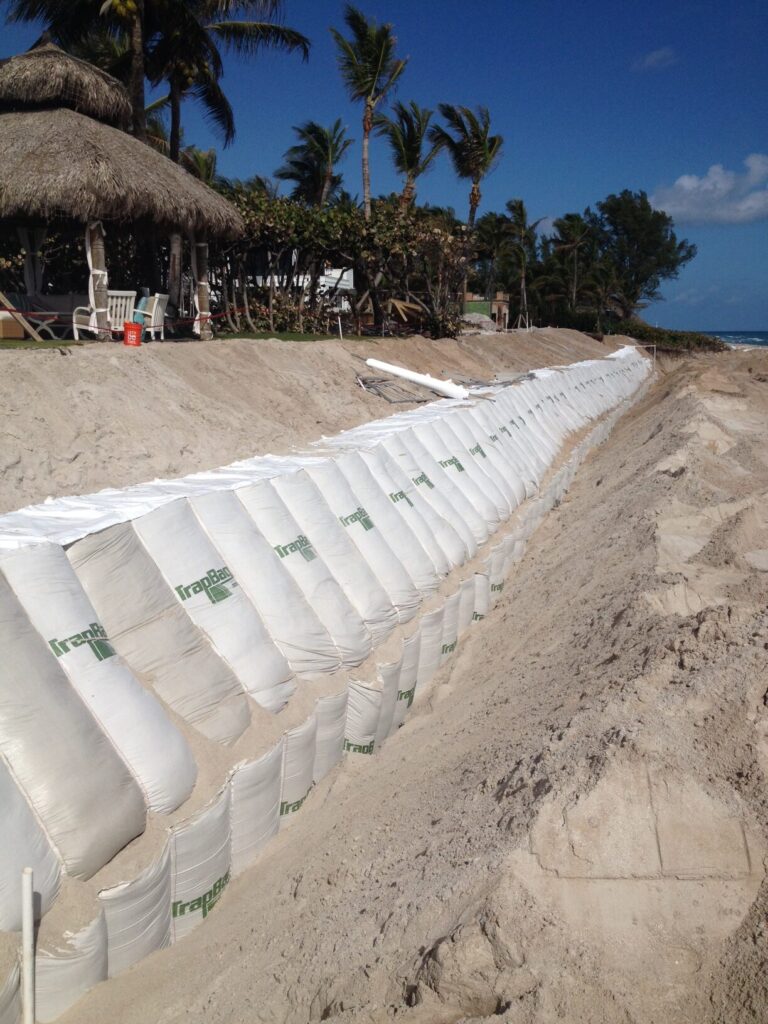TrapBag vs. Tiger Dam Erosion Protection Bags
Taking a look at TrapBags vs. Tiger Dam erosion protection bags can reveal many advantages and disadvantages of each. However, TrapBag still comes out on top.

When it comes to erosion protection and flood control, two popular options on the market are TrapBag® and Tiger Dams. While both solutions offer rapid deployment and effective flood mitigation, there are several key differences that make TrapBags the superior choice. By exploring the features and advantages of each option, you can make an informed decision for your erosion protection needs.
What Is a Tiger Dam?
Tiger Dams, also known as Tiger Bags, are temporary flood barriers made of high-strength geotextile material. These bags are designed to be rapidly filled with water, creating a barrier against rising floodwaters. While Tiger Dams may seem similar to TrapBags at first glance, there are some important distinctions to consider.
How Tiger Dams Work
Tiger Dams rely on water-filled bags as their primary means of flood control. When deployed, these bags are strategically positioned to create a barrier against oncoming water. The bags are typically made from durable materials that can withstand water pressure and provide temporary containment.
However, this approach introduces a few limitations compared to TrapBags. Unlike TrapBags, which can be filled with readily available onsite materials such as sand or gravel, Tiger Dams require a water source, such as a pump, fire hydrant, or hose, to fill the bags. This reliance on external water sources can be problematic during flood events when water availability may be limited or compromised. In such cases, the ability to quickly deploy and fill the bags with available materials, as offered by TrapBags, can be a significant advantage.
Another consideration with Tiger Dams is their size and stacking capability. While Tiger Dams can be stacked to increase the height of the barrier, the bags themselves are relatively short in comparison to TrapBags. This means that to achieve a sufficient barrier height, multiple layers of Tiger Dams would be required. This stacking process can be time-consuming and may hinder quick response times during emergency situations when rapid flood control measures are crucial.
Moreover, the need for multiple layers of Tiger Dams to protect against significant water volumes and debris can result in a more complex installation process. The strapping or fastening required to secure the multiple layers adds additional time and effort to the setup. In contrast, TrapBags, with their stackable design and customizable barrier heights, offer a more streamlined and efficient solution for achieving desired flood protection.
Reliable Erosion Protection: TrapBag Barriers
TrapBags are innovative and versatile flood barriers made from high-strength geotextile materials. These durable bags are specifically designed to provide reliable erosion protection, flood control, and sediment containment in various settings. Whether you need to safeguard infrastructure, protect coastlines, or prevent soil erosion on construction sites, TrapBags offer a practical and efficient solution.
What Makes TrapBags Superior?
- Durability: TrapBags are constructed from high-strength geotextile materials that are specifically engineered to withstand the rigors of erosion and flood events. They are puncture-resistant and UV-stabilized, ensuring long-term durability even in harsh environmental conditions.
- Reliability: With their robust design and solid construction, TrapBags provide a reliable barrier against floodwaters. Their leakproof design prevents water seepage, reducing the risk of compromised flood protection during critical moments.
- Stacking capability: TrapBags can be stacked to achieve the desired height and offer enhanced flood protection. Their modular design allows for efficient stacking, ensuring quick and effective barrier construction without compromising response time.
- Quick deployment: TrapBags are rapidly deployable, saving valuable time and effort during emergency situations. Their lightweight nature and simple installation process make them an ideal choice for swift flood response and erosion protection.
- Versatility: TrapBags can be customized to fit various flood scenarios and site conditions. They can adapt to different terrains, contours, and floodplain configurations, providing versatile erosion control and flood protection solutions.
What to Consider When Choosing Flood & Erosion Protection Methods
Size of Application Space
The size of the flood-prone area plays a crucial role in determining the appropriate flood barrier solution. TrapBags are designed to cover large sections of land, providing extensive coverage and comprehensive protection against erosive forces.
Functionality & Reusability
The expected height of floodwaters is an essential consideration when choosing a flood protection product. TrapBag barriers are available in various sizes, allowing for the selection of appropriate barrier heights to match the flood risk. While Tiger Dams are reusable, TrapBag barriers are intended for permanent installation, ensuring continuous protection without the need for repetitive setup and takedown.
Budget
Cost is an important factor in selecting the right erosion protection method. TrapBag barriers offer a cost-effective solution compared to traditional sandbags. With TrapBags, you can achieve the same level of protection using 40% less fill material, reducing overall costs without compromising effectiveness.
Industries that Trust TrapBags for Erosion Control
TrapBags have earned the trust of various industries for their exceptional erosion control capabilities. Here are some sectors that benefit from using TrapBags:
- Civil engineering: TrapBags are utilized in civil engineering projects to prevent erosion and protect infrastructure, such as bridges, culverts, and embankments.
- Coastal Engineering: TrapBags serve as valuable tools for coastal erosion control, protecting shorelines, seawalls, and other coastal structures.
- Construction: Construction sites often face erosion risks, and TrapBags offer a reliable solution for sediment control and erosion prevention during construction activities.
- Emergency management: TrapBags play a crucial role in emergency response efforts, providing quick and effective flood control in disaster-stricken areas.
- Environmental protection: TrapBags are instrumental in protecting sensitive ecosystems, wetlands, and habitats by preventing erosion and reducing sediment runoff.
- Infrastructure protection: TrapBags safeguard critical infrastructure, such as pipelines, utility installations, and transmission towers, from erosion and flood damage.
- Marine services: The marine industry benefits from TrapBags by preventing erosion around ports, marinas, seawalls, and other coastal structures.
- Mining & metal: TrapBags are utilized in mining operations to control erosion, manage sediment runoff, and protect mining sites.
- Public works & government: TrapBags are widely used by public works departments and government agencies to ensure erosion control, flood protection, and infrastructure resilience.
Protect Your Property with TrapBags
When it comes to erosion protection and flood control, TrapBags provide a reliable and versatile solution. Their durability, reliability, quick deployment capabilities, and cost-effectiveness make them the preferred choice for various industries and applications. Contact us today to learn more about TrapBag barriers and how they can safeguard your property from erosion and flooding.
Meet the author
Get the Dirt Before the Flood Hits
Stay ahead of flooding, erosion, and disaster response challenges. The Dirt, TrapBag’s monthly newsletter, delivers field-tested tips, real-world case studies, and the latest in barrier technology straight to your inbox.

